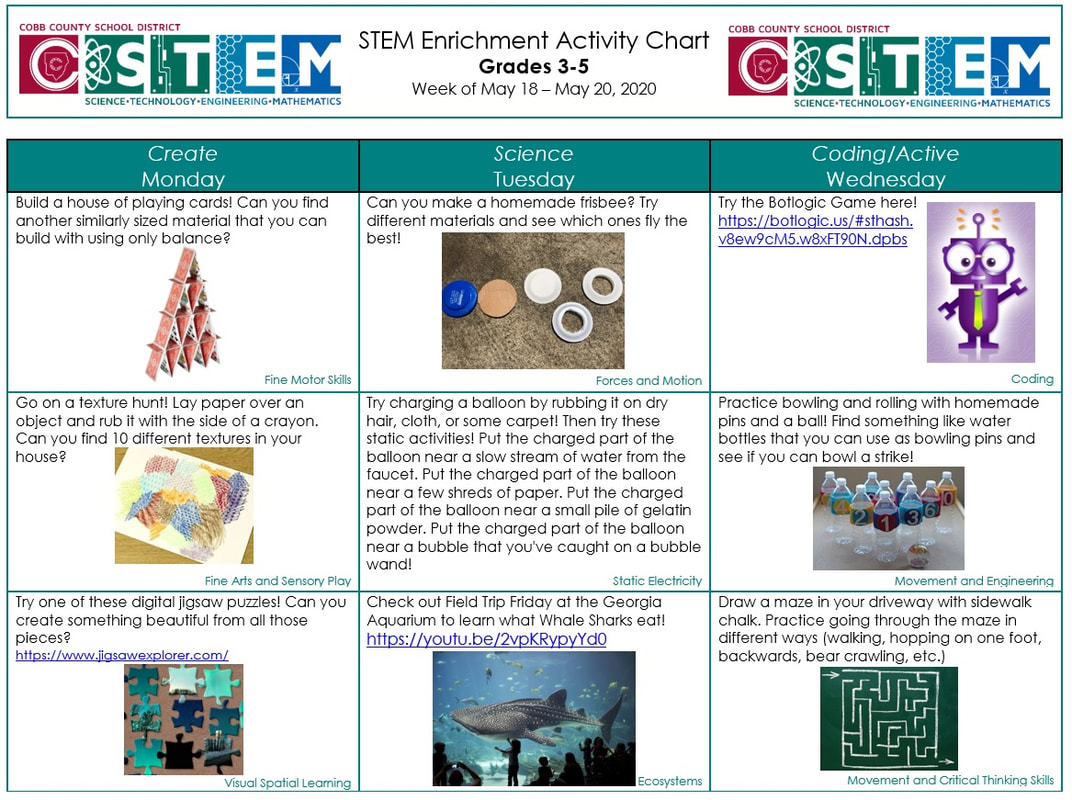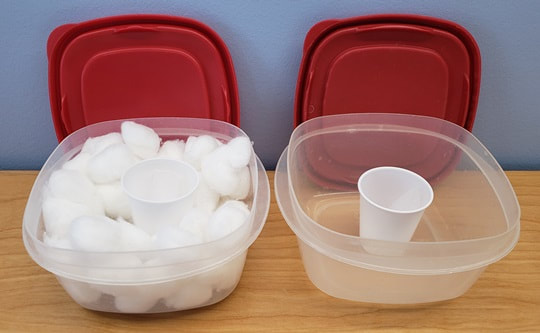| 3rd - 5th Choice Board.docx |
|
2 Comments
Welcome back to your final week of digital learning! You did it! Here's one last activity to get you to summer. At the end of the year, students learn to ask questions to identify and explain the uses of simple machines (lever, pulley, wedge, inclined plane, wheel and axle, and screw) and how forces are changed when simple machines are used to complete tasks (S4P3.c). We are going to build a simple machine and convert measurements from larger units to smaller units (MGSE4.MD.1).
Materials: Building materials you can find around your home- consider cardboard, craft materials like popsicle sticks, and common desk supplies. Materials needed are dictated by student designs! You know what comes first! Let's read and learn!
Let's try a simulation that lets you see balanced and unbalanced forces! Can you keep things balanced? Feel free to play here or click this link to play full screen: https://phet.colorado.edu/sims/html/balancing-act/latest/balancing-act_en.html
Now that you know how to keep forces balanced, we are going to create something to make them UN-balanced! Your challenge this week is a build a catapult that will launch a small item (like a penny or paper clip) as far as possible! Ask yourself, how could a launch a small item across the room using a simple machine? Brainstorm possible ideas! Consider which type of simple machine would make the best catapult and what materials you could use around your house to construct your design. With your parents' permission, gather materials and create your design. Evaluate your design by trying to use it. Does it work? Could you make it launch farther? Measure the distance that you're able to launch your small item and try converting it to other units. If you measure in meters, how many centimeters did it go? Check your work! Could you do anything to improve your design and launch things further? Have a blast launching items around your house and have an amazing summer!
All our love! Your STEM Cobb Team
Thanks for coming back to check out STEMCobb! This week, we will be using everyday materials to design and construct a device/structure that will decrease the warming effects of sunlight on ice cubes (S3P1.c). We will have to tell time to see how well our creations keep things cool (MGSE3.MD.1). Let's get into it! Materials: plastic tupperware container, small cup, ice, and insulation materials (students pick from items around the house) Let's start off with a great book. Check out some things that happen in the midst of a heat wave! Here are a few online activities that you can try out to be sure that you have a good understanding of temperature! Click on the photos to go to the games! Now it's time to try out a STEM challenge to help us understand more about decreasing the warming effects of the sun! Today, we are going to construct our own coolers! Ask yourself the question, what materials could I pack around a cup of ice to decrease the warming effects of the sun and keep the ice from melting? Brainstorm some materials that you think would keep the heat away from the ice. Here's a picture of the best way to set up this challenge. You can make adjustments to fit what you have at home! Once you've decided on the best insulation, work to design a whole cooler that keeps ice from melting in the sun! Set up 2 containers to help you see if what you choose to pack around the cup of ice slows down how quickly it melts, or if it melts at the same time as the cup with no insulation. Create your cooler and set it outside in the sun. Note the time! Here's how you can evaluate the material you chose! Check on the ice in both containers every few minutes and record the time when the ice in both cups melts. Use your awesome math skills to figure out how many minutes it took each cube to melt. Can you improve your design so that it takes longer for the ice to melt? Give it a try!
This week we are diving into the exciting world of simple machines! They are all around us and provide wonderful learning opportunities while we're at home. Students in upper elementary school should be asking questions to identify and explain the uses of simple machines (S4P3.c). Students also convert among different-sized standard measurement units (MGSE5.MD.1).
Materials: paper pencil measuring tool materials for building found around your house Let's learn simple machine basics with a song! Watch it once to enjoy the animation and beat, watch it again to be sure you understand what the words are teaching you! Type in your name and click "Join Session" below. This session will stay active until May 30th. 
Next, it's time to try one of the most fun apps EVER for learning about simple machines. Download INVENTIONEERS for free and see if you can build simple machines to accomplish silly tasks! This game does a great job of teaching how the combination of simple machines and gravity can accomplish big things!
Now it's finally time to work on a STEM engineering challenge. There are so many different simple machines challenges out there, but this is the one we liked the best! Today you are going to build a snack delivery launcher! Consider what you know about levers. Ask yourself, "How can I build a lever launcher that could send a snack across the room to a family member?" Consider using snacks like bites of cereal, fruit snacks, or goldfish. Brainstorm ideas for your design. Consider what you have handy at your house to build with. What could you build the lever from? What would make a good fulcrum? How long and high do both of those parts need to be? Once you've settled on a design, create it! Then take a stab at launching some snacks! Evaluate your construction: How far did they travel in inches? How far did they travel in feet? Did it make the snacks go the direction you intended? Take time to improve your design to make it launch more accurately. Have fun! Below are some design ideas in case you are stuck.
|
AuthorThese activities are being compiled by your STEMCobb team. Archives
May 2020
Categories |
||||||||||||






 RSS Feed
RSS Feed